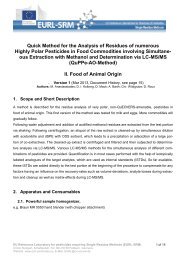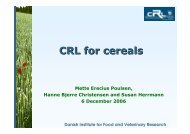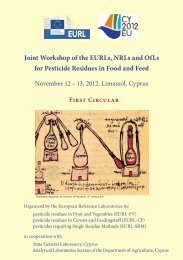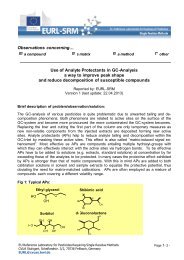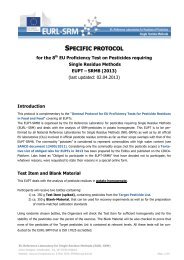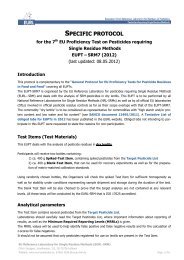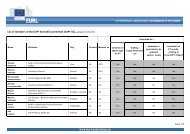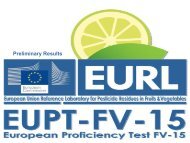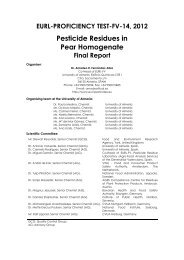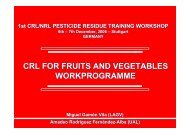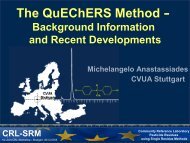QuPPe-AO - EURL | Residues of Pesticides
QuPPe-AO - EURL | Residues of Pesticides
QuPPe-AO - EURL | Residues of Pesticides
Create successful ePaper yourself
Turn your PDF publications into a flip-book with our unique Google optimized e-Paper software.
5. Procedure<br />
5.1. Sample preparation<br />
To obtain representative test-portions from the laboratory sample, proceed as required by the respective<br />
regulations and guidelines. Homogenize the eggs with a hand-blender (2.1) until a free flowing mixture is<br />
obtained. Proceed similarly with non-homogenized milk (e.g. if fat has separated).<br />
5.2. Extraction / Centrifugation / Filtration<br />
5.2.1. Weigh a representative portion (ma) <strong>of</strong> the sample homogenate (5.1) into a 50 mL centrifuge tube<br />
(2.2). In case <strong>of</strong> fresh milk and fresh eggs take 10 g 0.05 g <strong>of</strong> the homogenized sample.<br />
5.2.2. Add water (3.1) to a content <strong>of</strong> ca. 10 g in total. In the case <strong>of</strong> cow milk (88 % water) add 1.2 g <strong>of</strong><br />
water and in case <strong>of</strong> chicken eggs (76% water) add 2.4 g <strong>of</strong> water.<br />
Notes:<br />
- Where no IL-ISTDs are used or where they are added after extract aliquotation, water adjustment is<br />
essential. Where the appropriate IL-ISTDs are employed before any aliquotation has taken place<br />
water adjustment is less critical and can be skipped for commodities containing ≥80% water.<br />
5.2.3. Add 10 mL acidified methanol (3.6) and 50 µL <strong>of</strong> the ISTD-WS I (3.15) containing isotopically la-<br />
beled analogues <strong>of</strong> one or more <strong>of</strong> the analytes <strong>of</strong> interest (added ISTD mass = mISTD sample ).<br />
Notes:<br />
- For screening purposes the ISTD can be alternatively added to an aliquot <strong>of</strong> the final sample extract<br />
(see 5.2.10)<br />
5.2.4. Close the tube and shake vigorously for 1 min by hand or for 5-20 minutes by a mechanical shaker.<br />
5.2.5. Centrifuge for 5 min at >3000 g.<br />
5.2.6.Transfer a 2 mL aliquot into a 10 mL centrifuge tube with screw cap (2.3), which already contains the<br />
2 mL <strong>of</strong> acetonitrile (3.3) and 100 mg <strong>of</strong> ODS sorbent (3.7).<br />
5.2.7. Close the tube and shake vigorously for 1 min by hand.<br />
5.2.8. Centrifuge (e.g. for 5 min at >3000 g).<br />
5.2.9.Filter an aliquot (ca. 3-4 mL) <strong>of</strong> the extract through a syringe filter (2.7) into a sealable storage ves-<br />
sel.<br />
5.2.10. Transfer, as required, one or more aliquots (e.g. 1 mL each) into auto-sampler vials (2.9)<br />
Notes:<br />
- The cleaned-up extract will contain ca. 0.25 g sample equivalents per mL extract (if 10 g sample<br />
are employed for extraction).<br />
- Instead <strong>of</strong> adding the ISTD at the beginning <strong>of</strong> the procedure it can be added to an aliquot (e.g. 1<br />
mL) <strong>of</strong> the final sample extract. This way the added amount <strong>of</strong> ISTD per sample can be drastically<br />
reduced (e.g. 40-fold if added to 1 mL extract). The ISTD added at this step will compensate for ma-<br />
EU Reference Laboratory for pesticides requiring Single Residue Methods (<strong>EURL</strong>-SRM)<br />
CVUA Stuttgart, Schaflandstr. 3/2, DE-70736 Fellbach, Germany<br />
Website: www.eurl-pesticides.eu, E-Mail: <strong>EURL</strong>@cvuas.bwl.de<br />
5 <strong>of</strong> 15



